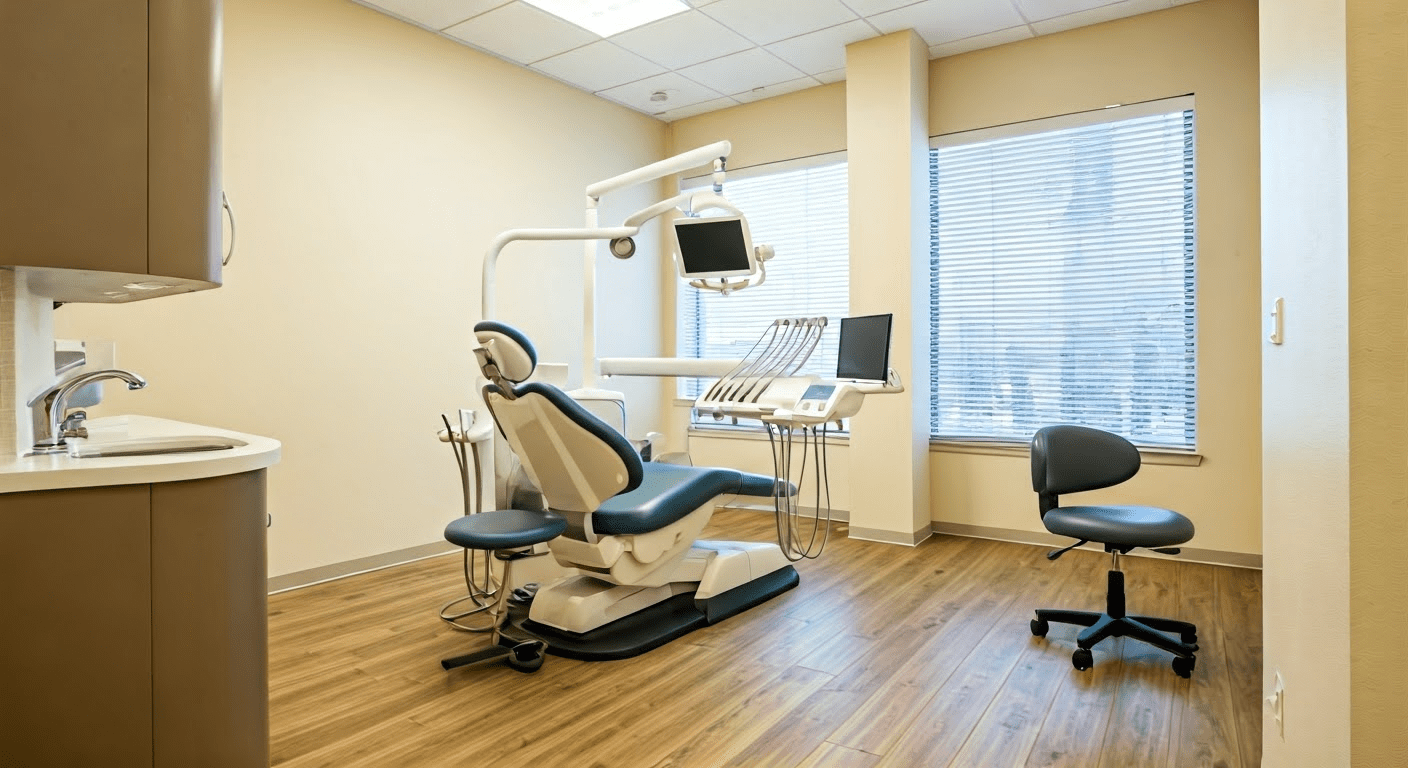Guide to Optimizing Your Dental Practice Performance

Running a successful dental practice takes more than clinical skill—it requires smart systems, clear data, and a unified team. Every process, from scheduling to patient care, can either fuel growth or create drag.
This guide offers a practical roadmap to help you build and refine the systems that drive efficiency, boost profits, and enhance patient experience—without burnout.
Ready to shift from reacting to problems to leading with purpose? Let’s get started.
What Is a Dental Practice Performance System?

A Dental Practice Performance System refers to a structured approach, often supported by software, processes, and metrics, that helps dental practices monitor, evaluate, and improve their overall performance. It’s designed to ensure clinical effectiveness, operational efficiency, financial health, and patient satisfaction.
Here’s a breakdown of what it typically includes:
Key Performance Indicators (KPIs) Tracking
KPIs are essential for measuring a dental practice’s success in achieving business objectives. Key financial and operational KPIs include:
- Patient Retention Rate – Measures the percentage of patients who continue to return for care, indicating loyalty and satisfaction.
- Case Acceptance Rate – Tracks the percentage of recommended treatments accepted by patients, reflecting treatment plan effectiveness.
- Production Per Hour/Day/Provider – Evaluates the efficiency and productivity of each provider, ensuring maximum utilization of time.
- New Patient Acquisition – Measures the number of new patients joining the practice, essential for business growth.
- Hygiene Reappointment Rate – Tracks how many patients schedule their next hygiene visit, indicating patient engagement and preventive care.
Operational Management Tools
Effective tools streamline daily operations:
- Scheduling Optimization – Ensures efficient use of provider time, minimizing gaps and overbookings.
- Staff Performance Tracking – Monitors staff productivity and effectiveness, helping identify areas for improvement.
- Inventory Management – Tracks and manages dental supplies, reducing waste and ensuring availability when needed.
- Patient Recall Systems – Automates follow-up reminders to encourage patients to return for regular visits, improving retention.
Financial Performance Analysis
Monitoring financial health is critical for practice growth:
- Overhead Costs – Tracks fixed and variable expenses to ensure profitability and sustainable growth.
- Profit Margins – Measures the difference between revenue and costs, indicating the financial health of the practice.
- Insurance Billing & Collections – Monitors the accuracy and timeliness of insurance claims, improving cash flow and reducing write-offs.
- Revenue Per Patient Visit – Evaluates how much revenue each patient generates, helping to assess overall business efficiency.
Clinical Quality Metrics
Maintaining clinical excellence involves tracking:
- Treatment Plan Completion Rates – Measures how often patients complete their recommended treatment plans, ensuring effective care delivery.
- Diagnostic Consistency – Ensures accurate and consistent diagnoses, improving clinical decision-making and patient outcomes.
- Compliance with Clinical Protocols – Tracks adherence to established clinical guidelines, ensuring quality and safety.
- Infection Control Audits – Assesses adherence to infection control standards, safeguarding patient health and preventing cross-contamination.
Patient Experience Monitoring
Ensuring high-quality care and satisfaction:
- Patient Satisfaction Surveys – Gather direct feedback from patients to assess their overall experience and identify improvement areas.
- Online Review Management – Monitors and responds to patient reviews online, enhancing the practice’s reputation and trust.
- Wait Times & Service Speed – Tracks patient wait times and service delivery speed, contributing to patient satisfaction.
- Communication & Education Quality – Evaluates how well staff communicate and educate patients about their care, fostering trust and engagement.
Software Platforms
Key software solutions support seamless performance tracking:
- Dentrix Ascend – A cloud-based practice management system that integrates scheduling, billing, and clinical records for streamlined operations.
- Eaglesoft – A comprehensive software platform for practice management, including patient scheduling, billing, and clinical charting.
- Open Dental – A flexible, open-source software offering customizable features for practice management and patient care.
- Dental Intelligence – A business intelligence platform that provides real-time data insights for improved decision-making and practice performance.
- Practice by Numbers – A cloud-based analytics tool that helps dental practices track and optimize key performance metrics.
These platforms integrate with electronic health records and billing systems, providing real-time analytics and reporting.
What Are The Common KPIs Used in Dental Practices?
Many KPIs can be utilized in dental practices, each providing insight into different aspects of your clinical and administrative operations. Here are some common KPIs widely used:
| Key Performance Indicator | Description |
|---|---|
| Collections Ratio | Measures the percentage of revenue collected from your total production. It helps assess the effectiveness of your billing and collection processes. |
| Patient Retention Rate | Measures the percentage of patients who continue visiting your practice over time. A high rate suggests patient satisfaction and loyalty. |
| Case Acceptance Rate | Measures the percentage of treatment plans presented to patients that are accepted and scheduled. It helps evaluate your clinic’s treatment presentation and patient communication. |
| Production per Hour | This financial metric measures gross production revenue generated per hour of clinical work, thus reflecting your dental team’s productivity and efficiency. |
| New Patient Conversion Rate | Measures the percentage of new patients who become regular, active patients in your practice, hence analyzing the effectiveness of your marketing efforts. |
| Appointment Attendance Rate | Measures the percentage of scheduled appointments that patients attend, indicating patient reliability and adherence to treatment plans. |
What Are The Benefits of a Dental Practice Performance System?
A Dental Practice Performance System helps streamline operations, improving efficiency and patient satisfaction. It also enhances financial management, allowing practices to track growth and optimize resources. Let’s look at its benefits in detail.
1. Streamlined Clinical and Admin Workflows
From the front desk to the clinical, optimized systems streamline every step of a patient’s journey. They reduce delays in scheduling appointments, creating treatment plans, managing billing, and handling follow-ups, ensuring that no time is wasted on administrative tasks. This efficiency allows the dental team to focus more on providing high-quality care, improving the patient experience, and increasing overall satisfaction. By automating and integrating processes, these systems enable practices to deliver a smoother, more coordinated service while maximizing productivity.
2. Increased Production and Profitability
Tracking provider performance, case acceptance, and collections in real-time gives you a clear, data-driven understanding of your practice’s strengths and areas for improvement. By closely monitoring these key metrics, you can identify patterns and trends that highlight potential growth opportunities.
3. Enhanced Patient Experience
An enhanced patient experience begins with streamlined check-ins, where patients can quickly and efficiently complete necessary forms or verify their information. This sets the tone for a visit that feels organized and thoughtful. Clear communication throughout the treatment process, from explaining procedures to addressing concerns, builds a stronger connection between patients and the dental team. Consistent care ensures that each visit meets high standards, fostering a sense of reliability and comfort.
4. Smarter, Data-Driven Decisions
Smarter, data-driven decisions rely on real-time KPIs like hygiene reappointment rates, chair utilization, and no-show trends. These insights help you make strategic improvements based on facts, allowing you to optimize operations, reduce inefficiencies, and enhance patient retention.
5. Stronger Team Performance
Stronger team performance starts with setting clear expectations, ensuring everyone knows their roles and goals. By measuring individual and team success, you can track progress and identify areas for improvement. Tools that support coaching allow leaders to provide targeted feedback, helping team members grow and excel in their roles. Fostering a collaborative environment enhances communication and accountability, leading to a more efficient, motivated, and high-performing team.
6. Scalable, Sustainable Growth
Scalable, sustainable growth is possible with systems that ensure consistency and clarity across your practice. These systems allow for expansion without compromising care quality or overwhelming your team. Streamlined processes help maintain efficiency, even with increased patient volume. This approach supports growth while preserving a positive work environment and high standards of care.
How To Utilize Dental Practice Management Software?
Dental practice management software (PMS) plays a crucial role in efficiently monitoring these KPIs within the dental industry. Use advanced tools that utilizes artificial intelligence to automate data collection, simplify PMS data analysis, and provide real-time insights into practice performance, helping you take your practice to the next level.
What Are The Features of Effective Software Systems?
An effective dental performance software system comes equipped with numerous features to make practice management more streamlined and efficient. Some of these features include:
Practice Analytics and Reporting:
This feature allows dental practices to generate comprehensive reports on various aspects of their operations, such as financial performance, patient demographics, and productivity metrics.
Inventory Management:
Keeping track of stock levels, sending alerts when supplies are low, and facilitating the reordering process with Amazon’s inventory solutions.
Streamlining Appointment Scheduling:
This feature enables efficient management of your appointment book, reducing scheduling conflicts, and optimizing the utilization of dental chairs and staff resources.
Customer Relationship Management (CRM):
A comprehensive CRM system helps you manage all aspects of your interactions and relationships with your customers, helping you improve business relationships, streamline processes and increase profitability.
Enhanced Patient Communication:
The system contains communication tools for improved patient engagement, satisfaction, and fostering better patient-provider relationships.
Seamless Integration with Treatment Planning:
Incorporating diagnostic records, financials, and treatment planning effectively within the software
What Happens When You Let Software Handle the Busywork?
Manual processes and outdated tools can quietly stall growth and create unnecessary friction in your practice. To run smoothly, profitably, and with less stress, your systems need to work as hard as you do. The right software doesn’t just support your daily operations—it elevates them.
High-performing dental practices are built on streamlined, intelligent systems that touch every part of the business, from patient experience to financial tracking.
Here’s how a well-integrated dental practice performance system can help your team operate at its best.
Streamlined Workflow and Efficiency
Manual workflows can drain your team’s time and energy, creating unnecessary stress and inefficiencies. By automating routine administrative and clinical tasks, performance systems help your dental practice operate smoothly and focus on what matters most: patient care.
Here’s how automation improves your practice:
- Appointment Scheduling: Simplifies booking, reminders, and cancellations, ensuring a smoother patient experience.
- Insurance Verification: Reduces errors and delays by automating insurance checks before appointments.
- Patient Communication: Automates reminders, recalls, and follow-ups, keeping patients informed and engaged.
- Treatment Plan Follow-Ups: Tracks patient progress and ensures timely action on recommended treatments.
- Charting and Billing: Streamlines documentation and reduces manual input, increasing accuracy and saving time.
- Staff Training and Onboarding: Simplifies training with standardized processes and easy-to-follow workflows.
Improved Patient Experience
Patients today expect the convenience and professionalism they receive from top-tier service industries. A performance system helps you meet and exceed those expectations by enabling:
- Online booking and confirmations
- Text/email reminders and recalls
- Digital intake forms and paperless check-ins
- Faster post-visit follow-up and billing clarity
This seamless journey reduces no-shows, increases retention, and strengthens the patient-provider relationship. Happy patients are more likely to return, refer others, and leave positive reviews that boost your online reputation.
Real-Time Data and Performance Tracking
Modern systems gather and analyze data automatically, allowing you to track essential KPIs such as:
- Daily/weekly production and collection totals
- Case acceptance and treatment plan follow-through
- Provider-specific performance metrics
- Hygiene reappointment rates
- Patient retention and acquisition trends
This real-time insight turns your practice into a data-driven operation. Instead of waiting for month-end reports, you can make timely decisions that directly impact revenue, efficiency, and patient care. You’ll identify areas of opportunity, address inefficiencies quickly, and measure the success of changes you implement.
Enhanced Team Communication and Accountability
One of the most overlooked challenges in running a practice is keeping everyone aligned and accountable. Performance systems often come with built-in tools for team management, including:
- Task assignments with deadlines
- Performance dashboards by role or department
- Goal tracking and real-time progress updates
- Internal messaging or notes on patient records
When everyone knows exactly what’s expected and can see how they’re contributing, motivation improves. You foster a culture of transparency and ownership, which leads to higher productivity, better service, and a more positive team environment.
Better Financial Management
A strong performance system enhances every part of the revenue cycle—from pre-visit insurance verification to post-visit billing and collections. With these tools, your practice can:
- Automate claims submissions and reduce denials
- Verify patient benefits in advance
- Set up digital payment options and plans
- Track aged receivables and follow up automatically
- Spot insurance trends and opportunities for coding optimization
All of this leads to faster payments, fewer errors, and reduced workload for your financial team. Ultimately, this means more consistent cash flow and less financial stress for the practice owner.
Compliance and Record-Keeping
Staying compliant with dental regulations, HIPAA laws, and insurance requirements can be a major challenge—especially when managing records manually. Performance software helps you:
- Maintain complete and secure digital records
- Automate backups and document retention policies
- Track consent forms, treatment notes, and audit trails
- Ensure role-based access to sensitive data
With everything digitized and centralized, you’re always prepared for audits, legal inquiries, or quality assurance checks. This reduces risk and supports a reputation for professionalism and trust.
Scalability for Growth
One of the greatest advantages of using a dental performance system is its ability to grow with your practice. Whether you’re opening a second location, adding more providers, or expanding your service offerings, a robust system ensures you can:
- Standardize processes across locations
- Share performance data across teams
- Maintain consistent patient experience and brand quality
- Easily onboard new team members or providers
- Adjust workflows without starting from scratch
This kind of scalability ensures that growth doesn’t come at the cost of control or care quality.
Streamlining Patient Communication and Scheduling
Effective patient communication and efficient scheduling are primary components of a successful dental practice. Streamlining these processes, along with handling new patient paperwork, goes a long way in enhancing the patient experience, reducing no-show rates, and showing rates of practice productivity.
What Are The Tools for Enhancing Patient Engagement?
Engaging patients goes beyond providing quality care—it’s about creating consistent, meaningful interactions that build trust and loyalty, especially in the context of the COVID pandemic. Dental practices can leverage a range of digital tools to strengthen these connections and enhance the overall patient experience.
Here are key technologies that support better patient engagement:
- Appointment Reminder Systems: Automated texts and emails reduce no-shows and keep patients informed about upcoming visits.
- Post-Treatment Follow-Ups: Personalized follow-up messages show care and attention, helping maintain strong relationships after treatment.
- Online Patient Portals: Give patients 24/7 access to their health records, appointment scheduling, prescription refills, and direct messaging with your team through an easy-to-manage interface.
- Patient Feedback Tools: Surveys and review systems help gather insights into patient satisfaction and highlight areas for improvement.
- Two-Way Communication Platforms: Secure messaging tools enable quick, convenient communication between patients and staff, enhancing responsiveness and connection.
Integrating these tools not only improves the patient experience but also supports long-term retention and practice growth.
Efficient Scheduling Systems
An efficient scheduling system is crucial for the smooth operation of a dental practice. It not only maximizes the utilization of dental chairs and staff resources but also enhances patient satisfaction by reducing wait times.
Software systems that automate appointment scheduling process make it highly accessible for patients to book preferred slots. Moreover, these systems reduce scheduling conflicts and last-minute cancellations by sending automated reminders. Optimized scheduling also ensures balanced workflow throughout the day, better management of walk-ins and emergencies, and staff’s ability to deliver timely and quality care to patients.
Financial Management in Dental Practices
Financial management is an integral part of a successful dental practice. Closely monitoring metrics related to revenue, collections, and expenses is vital in maintaining the financial health of your practice and achieving your financial goals. It aids dentists in gaining a comprehensive understanding of their earnings and expenditures, making it easier to plan accordingly.
Key Considerations for Financial Health
To maintain a financially healthy dental practice several key factors must be considered. Firstly, constant scrutiny of the practice’s revenue versus expenses is crucial. Ensuring effective billing and collection processes can help sustain a steady cash flow.
Attention should be paid to manage overheads carefully, keeping costs under control. Investment in advanced dental tools and technology can initially seem costly but in the long run, they yield a high return on investment through increased efficiency and productivity.
Lastly, having a proper insurance verification system in place can ensure prompt and correct claims submission, reducing denials and delays in payment. This aspect is crucial as insurance forms a significant part of the financial backbone in any healthcare set-up, including dental practices, helping to ensure that practices spend less time on administrative tasks.
Strategies for Improving Collection Ratios
Improving the collections ratio plays a pivotal role in maintaining the financial health of your dental practice. Here are some strategies to improve collection ratios:
- Verify Insurance: Prior to patient appointments, verify their insurance to avoid future payment issues.
- Pre-appointment Financial Discussions: Prior to treatment, discuss the cost and payment options with patients while adhering to applicable state laws. This sets clear obligations and reduces the chances of future non-payment.
- Prompt Billing: Ensure swift issuing of bills post-treatment to accelerate the collection process for prospective customers and the company owner by April. Customers need to sign an annual agreement to qualify for this prompt billing process.
- Provide Multiple Payment Options: Offering multiple payment options, including credit and debit payments or flexible payment plans, encourage timely payments.
- Follow-up: Persistent follow-ups on pending balances are essential till payments are closed.
Turn Your Dental Practice Data into Real Growth
Practice by Numbers helps dental practices unlock their full potential through the power of practice analytics software, analytics, and automation, enabling you to take control of your practice’s success. With real-time dashboards, actionable insights, and marketing tools built specifically for dentistry, we make it easy to track performance, increase production, and improve patient retention.
Whether you’re managing one location or a growing DSO, our platform gives you complete visibility into the health of your practice—so you can make smarter decisions, faster. Eliminate the guesswork, identify opportunities, and stay ahead of the competition with tools that actually move the needle.
Join thousands of successful practices already using Practice by Numbers to scale with confidence. Get a demo now!
Enhancing Efficiency and Growth in Your Dental Practice with Practice Management Software
Optimizing your dental practice is key to long-term growth and profitability. Using data-driven insights and valuable insights from KPIs can enhance efficiency, especially when investing in new equipment. Practice Management Software helps streamline operations by automating scheduling, improving patient communication, managing finances, and ensuring compliance, all while integrating seamlessly with your existing systems.
Frequently Asked Questions
What Are the Top KPIs Every Dental Practice Should Monitor?
Dental Practice Management Software and patient management software can considerably improve practice efficiency by automating appointment scheduling, streamlining patient communication, simplifying inventory management, generating comprehensive practice analytics, ensuring regulatory compliance, and integrating seamlessly with your existing practice management platform and treatment planning systems, taking care of all the legwork involved.
What Strategies Can Be Implemented To Enhance Patient Satisfaction?
Streamlining patient communication, enhancing appointment scheduling systems, offering flexible payment options, prioritizing patient comfort, and regularly collecting and implementing patient feedback are some strategies that can significantly enhance patient satisfaction in any dental practice.
How Can Dental Practice Management Software Improve Practice Efficiency?
Streamlining patient communication, enhancing appointment scheduling systems, offering flexible payment options, prioritizing patient comfort, and regularly collecting and implementing patient feedback are some strategies that can significantly enhance patient satisfaction in any dental office practice.




